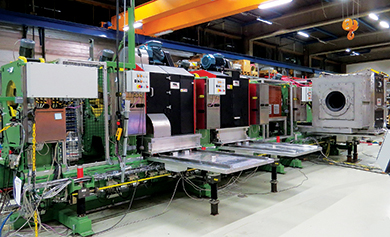
Taking ultrasonic testing to a new level - MACs new ECHOMAC® 500mm tester
Magnetic Analysis Corp. (MAC) has recently supplied its largest ever model Ultrasonic Rotary tester to a major Russian producer of OCTG pipe. Part of MAC’s line of Echomac® nondestructive Ultrasonic testers, this model can inspect tube and pipe up to 500 mm (19.6”) diameter. The Rotary test technique spins large numbers of transducers around the pipe as it passes through an enclosed rotary test chamber continuously supplied with pressurized water couplant. This design offers advantages of higher throughput speeds, quicker reconfiguration of transducers for different diameter material, repeatable test results, and 100 % coverage.
The new 500 mm UT tester can detect longitudinal and transverse crack type defects on OD and ID pipe surfaces, and throughout the product’s cross section, meeting standards that require finding artificial notches at a 5 % or 10 % level of the wall in pipe with any wall thickness. Many pipe grades require that the producer monitor the wall thickness for variations in dimensions, and some quality levels also require checking for lamination conditions. Grade PSL3 is the highest quality level and PSL2 and PSL3 both require being able to find a 6.3 mm diameter flat bottom drilled hole (FBDH) when testing for lamination. Test coverage is another standard, with Level PSL2 requiring test coverage of greater than 25 % of the pipe volume, and PSL3 requiring 100 % coverage. Enough transducers must be used so the helical pattern, as they scan the circumference, covers the required percentage of the pipe volume. Generally, wall thickness measurement could be conducted at the 25 % level, while lamination detection would need the 100 % coverage level. These high level quality grades are most likely to be required for pipe destined for higher risk offshore or environmentally sensitive applications. The Echomac UT test system, which also features MAC’s wireless transmission of test signals, can handle these tasks and ensure compliance with industry standards at throughput speeds up to 1 m/s.
The large multi-test system, recently supplied by MAC to the Russian pipe mill, combined the new 500 mm UT Rotary with 500 mm Transverse and Longitudinal Rotoflux® flux leakage testers to meet the specific needs of this mill for testing their pipe up to 426 mm diameter. Together, the dual technologies provide a far more comprehensive test. The Ultrasonic technology provides critical full inspection capability, including shear wave inspection of longitudinal and transverse defects at any quality level and wall thickness measurement and lamination detection. The addition of the UT rotary to the magnetic flux leakage testers provides complete all-direction test capability and gives the user full flexibility to optimize the pipe inspection process.
The two flux leakage units can test to 10 % OD and ID notch levels up to approximately 14mm wall thickness and 5 % OD and ID levels for thickness up to 12mm. The result of the combined test technologies is a system that is compliant with API 5CT and 5L, ASTM E570 and other standards, including those that require Ultrasonic testing as the first method and a second method at the discretion of the pipe producer.
The multi-test system was mounted on a custom constant center Triple Drive Roll Bench which can be automatically adjusted using Conductor controls to align the rotaries with the level of the incoming test material. The Triple Pinches guarantee a controlled entrance and exit from the test stations and need no manual settings when dimensions are changed. The system incorporated a number of other features and accessories, including a Demagnetizer to eliminate residual magnetism from the transverse Rotoflux unit; an add-on crane to move pole pieces when adjusting for major changes in tube dimension; a complete water circulation and chiller system; and paint markers .
Magnetic Analysis Corp., based in Elsmford, New York, US, with additional manufacturing facilities in Boardman, Ohio, US, and Östersund, Sweden, has been designing and manufacturing nondestructive test equipment for the metals industry since 1928.
